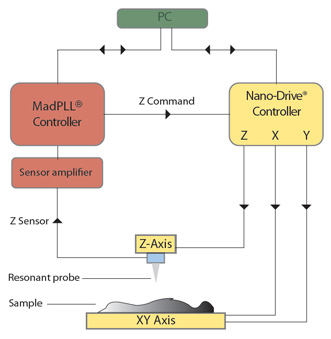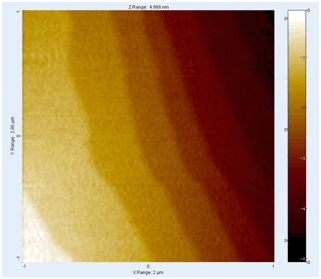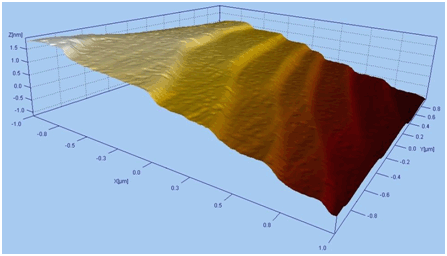

>>Measuring Atomic Steps
Sub-Nanometer Motion
Measuring Surface Roughness
Additional Information
PicoQ® Sensor Technology
MadPLL® Brochure
AFM Video Tutorial
Laser Focus World Article
Related Products
SPM-M Kit
Tuning Forks
MadPLL®
Nano-HS Series
Nano-LP Series
Questions?
E-Mail Us
Measuring Atomic StepsAll Mad City Labs piezo nanopositioning systems with PicoQ® sensor technology are independently calibrated using NIST-traceable interferometric methods. This calibration can be confirmed using atomic steps in Silicon (111). Mad City Labs piezo nanopositioners have unmatched precision and resolution due to the inherent low-noise properties of proprietary PicoQ® sensor technology. The performance of nanopositioners can be demonstrated using atomic force microscopy (AFM) to image atomic steps. The following test demonstrates that a nanopositioning system with PicoQ® sensor technology (model Nano-HS3) has sufficiently low position noise and high accuracy to resolve single atomic steps in Silicon (0.312 nm). This is further validation that Mad City labs piezo nanopositioners with PicoQ® sensor technology set the standard for high accuracy and lowest position noise. Please click on Testing Principle to view. Click a second time to collapse the topic. |
Testing Principle
The AFM probe tip is positioned in proximity to the sample surface using the Z-axis of a nanopositioner. The distance between the probe tip and the sample surface is directly related to the magnitude of the force between the tip and sample. The piezo nanopositioner is moved to maintain constant force between the tip and the surface. In a typical experiment, the tip is scanned along the X and Y axes. In this experiment, the Z-axis position is measured directly to provide a height measurement of the sample. Mad City Labs piezo nanopositioners include integrated, direct measurement position sensors with PicoQ® sensor technology, already calibrated using NIST-traceable interferometric methods. Any displacement of the moving portion of the piezo nanopositioner will yield a change in position sensor output, with the resolution ultimately limited by the noise of the nanopositioning system. Total AFM noise must be sufficiently low in order to externally measure sub-nanometer motion. Measuring the output of the nanopositioner's absolute position sensors assures accurate scan size and Z-axis position of the probe as it scans over the surface. |
Test SetupIn the following test, the AFM instrument consisted of a Nano-HS3 with PicoQ® sensor technology for XYZ probe motion mounted on a SPM-MZ for Z axis coarse approach. A MadPLL® was used for closed loop feedback to maintain probe position in Z and an etched Tungsten tip attached to a quartz tuning fork was used as the imaging probe. Data were acquired using AFMView™ software, and analyzed and presented using SPIP® software.
|
Silicon Atomic Step TestA Silicon (111) substrate of single atomic layer steps was placed underneath the AFM described in the Test Setup section, above. Silicon (111) has a stated monatomic layer thickness of 0.312 nm. Using such a well-known and well-defined physical sample allows for accurate characterization of the AFM's accuracy and resolution, and therefore the accuracy and resolution of the nanopositioning system that is part of the AFM. This Silicon substrate has been previously confirmed to be an excellent AFM calibration sample, see M. Suzuki et al. Standardized procedure for calibrating height scales in atomic force microscopy on the order of 1 nm. J. Vac. Sci. Technol. A 14, 1228 (1996). The demonstrated low-noise properties of piezo nanopositioning systems with PicoQ® sensor technology allow for precise surface height measurement at the picometer scale when used as part of an AFM instrument. A lateral XY scan of the sample with simultaneous Z-axis position sensor measurements yields the topographic structure of the sample.
Based on these measurements, the average step height was calculated as 311 pm with a standard deviation of 3 pm. Orji, et al derived an accepted value of 312 +/- 12 pm. These data externally verify the position resolution and low noise of Mad City Labs piezo nanopositioners with PicoQ® sensor technology in a relevant, real world application. The data also verify the accuracy of PicoQ® sensor technology, which were independently calibrated using NIST-traceable interferometry. The Si (111) atomic step-height measured by the position sensor is consistent with the previously derived accepted value. [Orji, et al. Traceable pico-meter level step height metrology. Wear 257:12, 1264-1269 (2004)] |
Additional Information | ||
|
Laser Focus World Article  NANOPOSITIONING: Piezoelectric nanopositioners forge low-cost atomic force microscope |
AFM Video Tutorial |
MadPLL® Brochure |
Related Products |
Copyright © 2024


